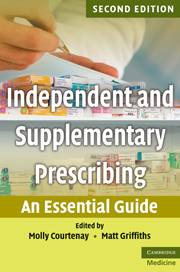Book contents
- Frontmatter
- Contents
- List of contributors
- Foreword to the second edition
- Preface to the second edition
- 1 Non-medical prescribing: an overview
- 2 Non-medical prescribing in a multidisciplinary team context
- 3 Consultation skills and decision making
- 4 Legal aspects of independent and supplementary prescribing
- 5 Ethical issues in independent and supplementary prescribing
- 6 Psychology and sociology of prescribing
- 7 Applied pharmacology
- 8 Monitoring skills
- 9 Promoting concordance in prescribing interactions
- 10 Evidence-based prescribing
- 11 Extended/supplementary prescribing: a public health perspective
- 12 Calculation skills
- 13 Prescribing in practice: how it works
- 14 Minimising the risk of prescribing error
- Index
Foreword to the second edition
Published online by Cambridge University Press: 10 January 2011
- Frontmatter
- Contents
- List of contributors
- Foreword to the second edition
- Preface to the second edition
- 1 Non-medical prescribing: an overview
- 2 Non-medical prescribing in a multidisciplinary team context
- 3 Consultation skills and decision making
- 4 Legal aspects of independent and supplementary prescribing
- 5 Ethical issues in independent and supplementary prescribing
- 6 Psychology and sociology of prescribing
- 7 Applied pharmacology
- 8 Monitoring skills
- 9 Promoting concordance in prescribing interactions
- 10 Evidence-based prescribing
- 11 Extended/supplementary prescribing: a public health perspective
- 12 Calculation skills
- 13 Prescribing in practice: how it works
- 14 Minimising the risk of prescribing error
- Index
Summary
The extension of the authority to prescribe has moved on apace since the publication of the Review of the Prescribing, Supply and Administration of Medicines in 1999. Now nurses, pharmacists, allied health professionals and optometrists, as well as doctors and dentists, can prescribe. These rapid developments have set challenges for professional and regulatory bodies and for individual practitioners. However, all concerned have risen to these challenges with energy and enthusiasm. Training programmes are well developed, many nurses, pharmacists and allied health professionals have completed training, and the benefits to patients are already being felt.
This book is timely and I would like to congratulate Molly Courtenay and Matt Griffiths on bringing together a group of distinguished contributors who have produced an authoritative and comprehensive account of all aspects of prescribing. I am sure that it will prove invaluable both as a practical guide to new prescribers and as a continuing reference source.
I hope that this book will not be seen only as a book for the new prescribing professions. Its thorough examination of all aspects of the prescribing process and the implications of extended prescribing for multidisciplinary teams should also commend it to existing prescribers. It is a valuable text for every professional who is learning to prescribe or who wishes to improve their practice.
I have no doubt that Independent and Supplementary Prescribing will inform and support prescribers and that it will make an important contribution to improvements in both the quality and accessibility of patient care.
- Type
- Chapter
- Information
- Independent and Supplementary PrescribingAn Essential Guide, pp. ix - xPublisher: Cambridge University PressPrint publication year: 2010

